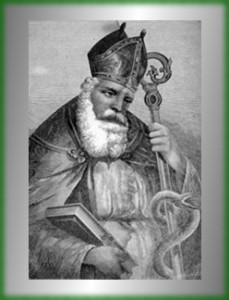 There are many myths and legends about our beloved Saint Patrick as well as many disagreements on his history. So, to start we have provided below a general overview of what is generally provided as a history on his life. We’ve included writings attributed to him under our St. Patrick’s Writings section.
There are many myths and legends about our beloved Saint Patrick as well as many disagreements on his history. So, to start we have provided below a general overview of what is generally provided as a history on his life. We’ve included writings attributed to him under our St. Patrick’s Writings section.
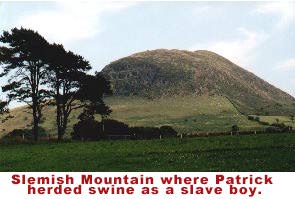 It is believed that St Patrick was born in the year 387. His given name was either Maewyn or Succat, (Celtic for ‘clever in war’). It is believed that Pope Celestine renamed him Patricius after his consecration as a bishop. This evolved into the name Padraig or Patrick that we know him by today. Fifth century Ireland is a lost world, virtually closed to both historians and archaeologists, and what little is known about life and work of Patrick comes from his own writings in Latin, now accepted as authentic, and from brief references in annuals written about two centuries later. In his Confessions, an apologia written in his old age rough Latin, Patrick says that he was a native of Roman Britain, the son of Calpurnius and Conchessa, who lived in the village of Bannaven Taberniae. Scholars disagree as to its location, ascribing it variously to Cumberland, the Severn valley, the island of Anglesey or in the area of Strathclyde. His father was evidently a man of position and the son of a priest and his mother, Conchessa, was a near relative of the great patron of Gaul, St. Martin of Tours. At the age of 16, he was captured by Irish raiders, and sold into bondage to tend sheep and swine on the slopes of Slemish mountain in Antrim for a chief named Milchu. During this time, his thoughts turned to God, and he spent many hours in solitary prayer.
It is believed that St Patrick was born in the year 387. His given name was either Maewyn or Succat, (Celtic for ‘clever in war’). It is believed that Pope Celestine renamed him Patricius after his consecration as a bishop. This evolved into the name Padraig or Patrick that we know him by today. Fifth century Ireland is a lost world, virtually closed to both historians and archaeologists, and what little is known about life and work of Patrick comes from his own writings in Latin, now accepted as authentic, and from brief references in annuals written about two centuries later. In his Confessions, an apologia written in his old age rough Latin, Patrick says that he was a native of Roman Britain, the son of Calpurnius and Conchessa, who lived in the village of Bannaven Taberniae. Scholars disagree as to its location, ascribing it variously to Cumberland, the Severn valley, the island of Anglesey or in the area of Strathclyde. His father was evidently a man of position and the son of a priest and his mother, Conchessa, was a near relative of the great patron of Gaul, St. Martin of Tours. At the age of 16, he was captured by Irish raiders, and sold into bondage to tend sheep and swine on the slopes of Slemish mountain in Antrim for a chief named Milchu. During this time, his thoughts turned to God, and he spent many hours in solitary prayer.
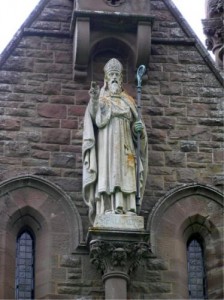
This statue depicts Palladius, who was sent to Ireland by Pope Celestine in the fifth century and was the first Bishop of Ireland.
It is understood, based on his writings, that after six years he escaped, and made his way home. He relates how in a vision he saw a man who came from Ireland with letters, and how he heard the voices of the Irish imploring him to return. He does not say where he studied under the Church, but tradition makes him a disciple of St. Germanus of Auxerre, and he may also have spent some time at Tours and at the monastic island settlement on Lerins off the coast of Provence. According to the Chronicle of Prosper of Aquitane, a contemporary source, Pope Celestine sent one Palladius in the year 421 to assist the Irish believing in Christ, to be their bishop. This piece of evidence suggests that there were Christians in Ireland at that time in numbers sufficient to warrant the appointment of a bishop. According to tradition, Palladius’ mission had little success, and he was forced to leave within a few months, dying in Scotland about 431.
The uncertainty surrounding the date of Saint Patrick’s arrival has occasioned the theory of two Patrick’s, whose careers were confused by later chronicles, but this remains merely theory. It seems reasonably certain that St. Patrick’s mission spanned some thirty years in the latter half of the fifth century that it was very successful and that Ireland, unlike any other country in Western Europe, was converted to Christianity without the shedding of martyrs’ blood. In his own words, the Saint ‘baptized thousands, ordained clerics everywhere and rejoiced to see the flock of the Lord in Ireland growing splendidly.’ It is probable that most of his missionary was carried out in the Northern half of the country. The date and place of his death are uncertain, but many agree it was around the year 493 AD; tradition says that he died at Saul, near Downpatrick, Co. Down, on 17 March, the day now celebrated as the national festival and what we now like to refer to as Saint Patrick’s Day.
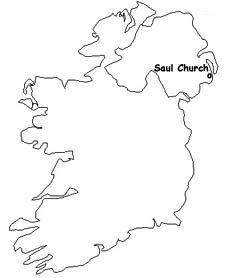
The legends which accumulated around St. Patrick’s life go far beyond the meager details related above, which include all that is known about him with any certainty. This story of his explaining the mystery of the Holy Trinity by showing a three-leaved shamrock to the King at Tara 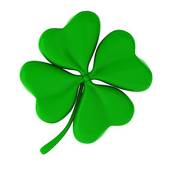 ; the lighting of the Paschal fire on the hill of Slane; the destruction of the idol, Crom Créuach; the banishing of snakes from Ireland – these are all apocryphal accretions of later dates. So also is the identification of Saul as the site of his first church. Croagh Patrick, where he said to have kept his Lenten fast and now a place of Pilgrimage, has been claimed, with Slemish, as the scene of his captivity as a boy. His original Celtic name is said to save been Succat, Patricius being his Latin designation.
; the lighting of the Paschal fire on the hill of Slane; the destruction of the idol, Crom Créuach; the banishing of snakes from Ireland – these are all apocryphal accretions of later dates. So also is the identification of Saul as the site of his first church. Croagh Patrick, where he said to have kept his Lenten fast and now a place of Pilgrimage, has been claimed, with Slemish, as the scene of his captivity as a boy. His original Celtic name is said to save been Succat, Patricius being his Latin designation.
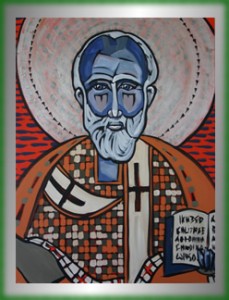 There are many writings attributed to St. Patrick which are accepted as authentic including his Epistle to Cortices, a fine hymn in Irish, and the Breastplate of St. Patrick. The Epistle, written in Latin, beseeches Coroticus, a British chief, to free some Irish Christians whom he had taken captive. There is a great lack of knowledge of life in Ireland in the fifth century but the author of Confessions and the Epistle emerges as a real personality; the vividness of his narrative and the undoubted success of his mission account for the central place he came to occupy in Irish tradition, and the hold he exercised over the imagination of the chronicles and storytellers of later centuries.
There are many writings attributed to St. Patrick which are accepted as authentic including his Epistle to Cortices, a fine hymn in Irish, and the Breastplate of St. Patrick. The Epistle, written in Latin, beseeches Coroticus, a British chief, to free some Irish Christians whom he had taken captive. There is a great lack of knowledge of life in Ireland in the fifth century but the author of Confessions and the Epistle emerges as a real personality; the vividness of his narrative and the undoubted success of his mission account for the central place he came to occupy in Irish tradition, and the hold he exercised over the imagination of the chronicles and storytellers of later centuries.
